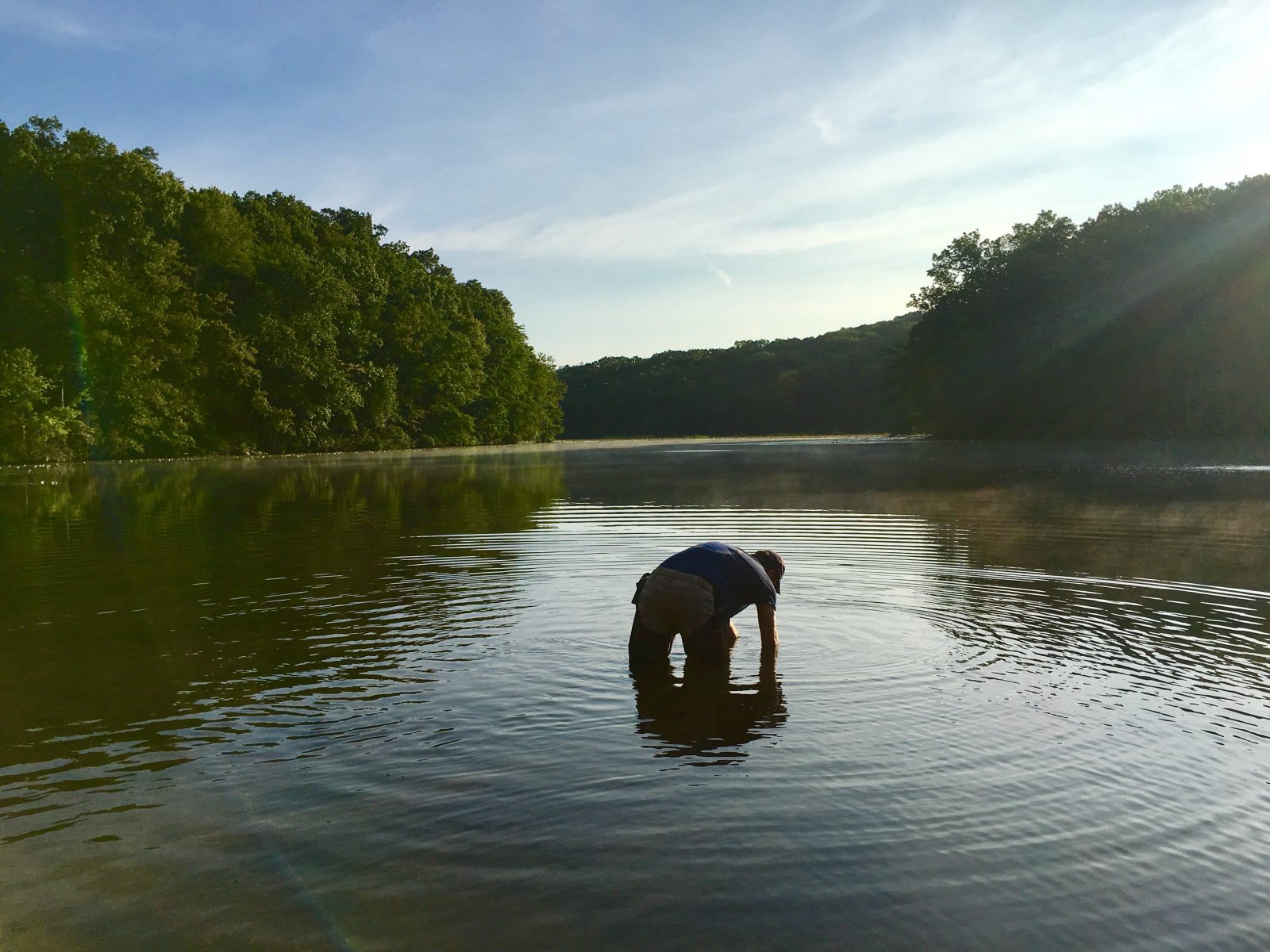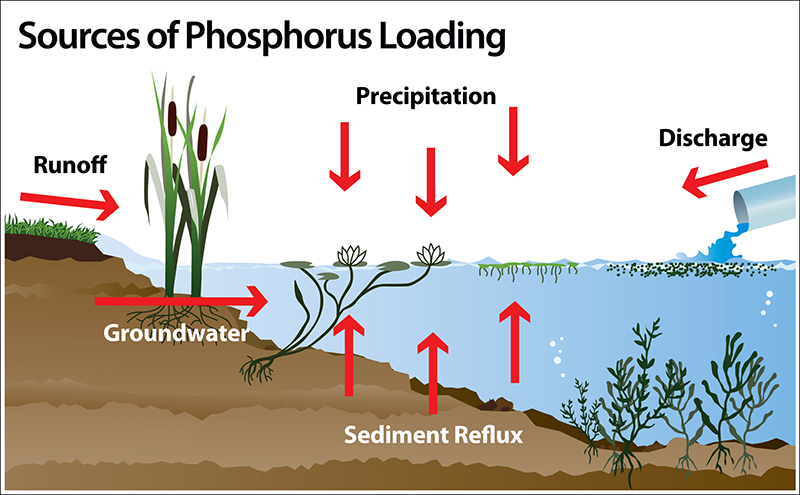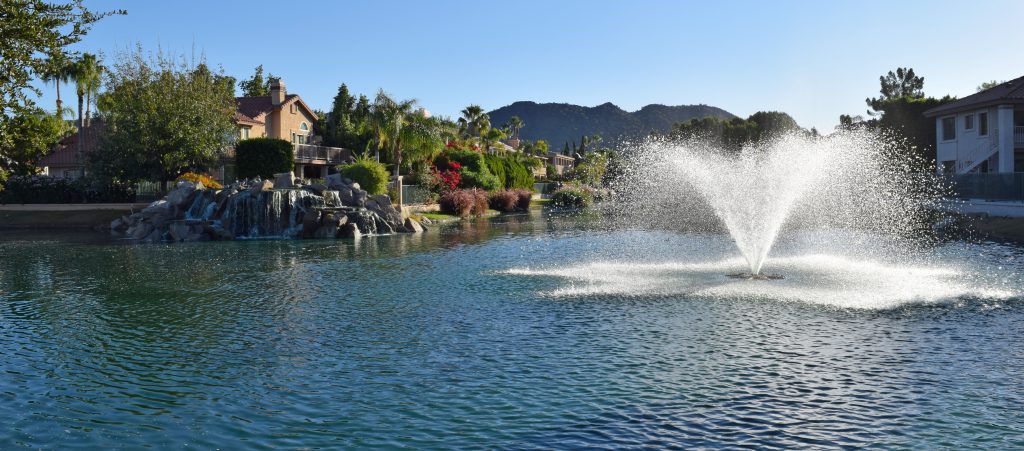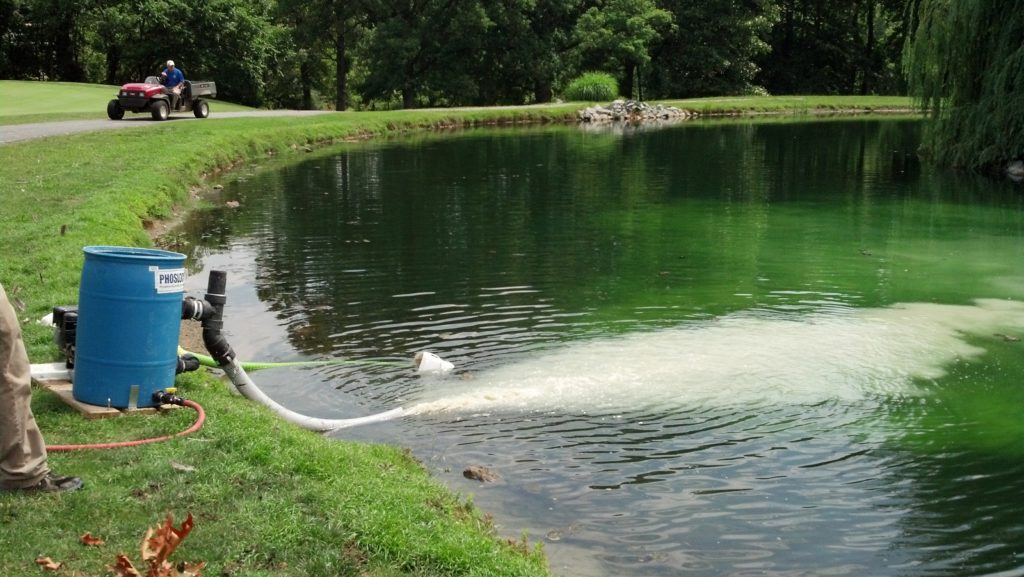
Improving Pond Water Quality Through Phosphorus Reduction
AS SEEN IN Virginia Turfgrass Journal
“Nutrient Management” has become a ubiquitous term in the water management industry. Environmental concerns about excess nutrients leaching into groundwater or running off into surface waters have plagued the industry for years, and have led to an industry-wide dedicated effort to improve turf management practices and fertilization programs. Government restrictions on fertilizer applications have become more extensive, and the emphasis on nutrient management continues to grow. The use of written Nutrient Management Plans has become more widespread, and more sustainable practices are being implemented to secure the status of lake and pond managers as environmental stewards.
There is no denying the fact that excessive nutrients can have deleterious effects on our ground and surface water. As lake managers, we deal with the implications of nutrient loading on a daily basis. Ponds with increased nutrients often suffer from cyanobacteria and algae blooms, surface biofilms, dense submersed plant growth, and related oxygen depletion. Reducing nutrient inputs to water bodies and mitigating the effects of nutrient loading are the key factors in successful lake management programs, with phosphorus being the primary nutrient of concern for our industry. Therefore, understanding how to reduce phosphorus in water is at the core of nutrient remediation.

Ponds and lakes are central features of golf courses, communities, and commercial or private properties. Not only are they beautiful accessories to the landscape, but in many cases they are also critical sources of irrigation water. The ponds need to be maintained in an aesthetically pleasing state, with water quality that is conducive to irrigation and free of vegetation that will continually clog the intakes.
There are few scenarios more challenging to a lake manager than the restoration of the ecological health and aesthetic integrity. The most obvious difficulty is the restriction on the herbicides that can be used for treatment of submersed and floating nuisance aquatic vegetation. For many of the species that we find the most difficult to control, the herbicide of choice would be one that is not safe to use in irrigation water without damaging the receiving turf and ornamental vegetation. For our clients, we need to focus on sustainable and cost-effective strategies that will allow them to meet their goals for both their ponds and their turf.
Nutrient management and reducing phosphorus in water is a challenge. Integrated Pest Management Plans for nuisance aquatic vegetation control include strategies to prevent nutrients and sediment from entering water bodies in the first place. Filter strips of turf or dense buffers of native vegetation are recommended around the shorelines of ponds and lakes to filter runoff. Because the water level in irrigation ponds can fluctuate so dramatically, shoreline stabilization is particularly important to prevent erosion of the soil and the associated nutrient loading. However, preventive strategies have little effect on ponds that are already impaired, and mitigation efforts within the pond are required to reverse the effects of long-term eutrophication.

There are many successful methods for removing phosphorus from a pond once it has accumulated there. Obviously, mechanical dredging to remove the unconsolidated sediment layer is the most direct mitigation strategy, although the process is highly disruptive and extremely expensive. Pond aeration can be used in concert with naturally occurring or inoculated beneficial bacterial to accelerate the decomposition of organic matter and prevent the accumulation of excess nutrients. However, very little phosphorus is required to support algal blooms, and it is unlikely that these strategies alone will be sufficient to mitigate phosphorus loading in severely impaired ponds.
The application of aluminum salts (alum) has been used for over 30 years to remove phosphorus from the water column and to control its release from the sediment. This method of phosphorus inactivation can actually reverse the effects of nutrient loading on ponds and lakes. However, it does have limitations, especially in shallow pond environments.
For smaller or shallower waterbodies, lanthanum modified bentonite clay can be applied to the water surface as a granule or a slurry to bond with free reactive phosphorus. The lanthanum adsorbs phosphate molecules to form a mineral called rhabdophane, which is extremely stable at in situ pH levels. Any unreacted lanthanum remains imbedded in the bentonite granules, which settle to the bottom of the pond to form a permeable layer that will continue to bond and sequester phosphorus as it releases from the sediments.

There are many benefits to the use of lanthanum to help reduce phosphorus in water. Most importantly, its effectiveness is not dependent on the physic-chemical properties of the water body, so it works well in a wide range of pH levels (~4-11), as well as under anoxic conditions. Also, since the unreacted lanthanum does not release from the bentonite until it reacts with phosphate, there is a very low concentration of dissolved lanthanum in the water body and no associated toxicity to aquatic organisms. Lanthanum modified clay application is an extremely safe and effective method of permanent phosphorus removal that can be implemented in water bodies with a broad range of ecological characteristics.
In order to implement an effective phosphorus reduction strategy with lanthanum, it is essential to have a good understanding of the water quality in the pond, as well as the phosphorus levels in both the water column and the sediment. Ideally, sampling should be conducted in the absence of an active algae bloom to establish a baseline for the water quality and to calculate the total amount of phosphorus in the water body. Because 100 kg of the lanthanum product can inactivate 1 kg of phosphorus, it is possible to calculate the amount of product required for mitigation based on the water and sediment testing with fairly high accuracy.
The physical application of the calculated quantity of the lanthanum product can be performed all at once, or it can be phased over multiple years to compensate for budgetary considerations. Since most of the phosphorus in a water body has accumulated over many years, it is an acceptable strategy to stage the mitigation over several years as well. Once the initial phosphorus load is completely mitigated, annual maintenance applications can be performed to account for new inputs to the water body. However the mitigation plan is implemented, the results will be improved water quality and reduced issues with cyanobacteria and other algal species.
Nutrient management will continue to be a critical issue in the lake management industry. While it is true that improved turf management practices, fertilization programs, and integrated pest management strategies can reduce the inputs of nutrients to our surface waterways, eutrophication is an ongoing process that can be slowed but not completely prevented. It is promising that there are mitigation techniques available to reduce phosphorus in water that will ultimately continue to occur despite our best efforts.
Want to know How to Reduce Phosphorus in Water?
Contact the phosphorus reduction experts at 888-480-5253 or complete the form below.
SOLitude Lake Management is an environmental firm committed to providing full-service solutions that improve water quality, preserve natural resources, and reduce our environmental footprint. Our services include lake, pond, wetland and fisheries management programs, algae and aquatic weed control, mechanical harvesting, hydro-raking, installation and maintenance of fountains and aeration systems, water quality testing and restoration, bathymetry, lake vegetation studies, biological assessments, habitat assessments, invasive species management and nuisance wildlife management. Services, consulting and aquatic products are available to clients nationwide, including homeowners associations, multi-family and apartment communities, golf courses, commercial developments, ranches, private landowners, reservoirs, recreational and public lakes, municipalities, parks, and state and federal agencies. Learn more about SOLitude Lake Management and purchase products at www.solitudelakemanagement.com









